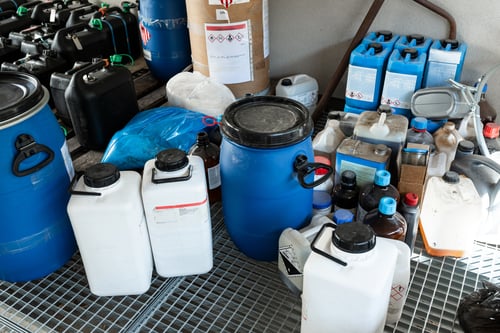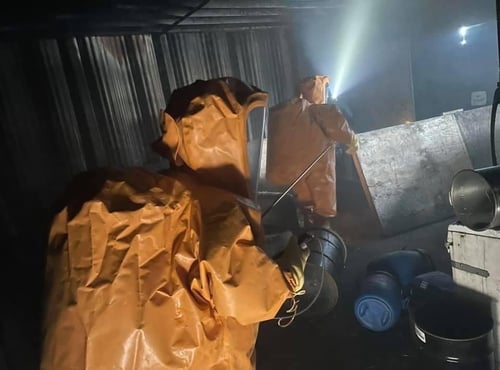First responders need presumptive ID technology to better assess and act on hazardous incidents

This article first appeared on GCN.com
May 23, 2023 - Public safety professionals have one of the most dangerous occupations in this country. When they respond to an emergency call and arrive on scene, they may encounter any number of threats or hazards. While there are many complex threats, the dangers posed by chemicals and narcotics, such as fentanyl, are significant and increasing on a daily basis.
Once on scene, first responders have a very short window of opportunity to assess the situation and implement a lifesaving tactical response. Their response to any situation is defined by what has happened, what caused it, if there is an ongoing threat, the nature of that threat and who might be at risk.
Reducing or eliminating danger typically required immediate knowledge of the presence of hazardous materials or conditions. Without specific information on the nature of the material, victims and responders are vulnerable.
Unfortunately, the presence of hazardous chemicals, materials or conditions at an incident site will likely delay many responder actions until those threats are identified. Providing presumptive identification capabilities to first responders enables them to do immediate analysis and develop the best mitigation strategy.

Top threats first responders most typically face and the impacts
All public safety first responders, whether law enforcement, firefighters or emergency medical personnel, share duties at an emergency scene. But each has unique tasks that put them at different levels of personal risk, and they can benefit from hazardous materials identification for different types of threats.
Consider the case of a police officer who makes a routine traffic stop and has reason to suspect there may be narcotics in the vehicle. None are visible, but the driver has a history of drug violations. The officer needs an effective way of partially 'analyzing' the vehicle and its contents, but in a manner that doesn't put them in direct contact with any compounds found or violate the driver's rights.
For firefighters, the danger might be from toxic fumes or spilled chemicals in a building that is being used to manufacture narcotics, such as methamphetamine. Firefighters would be reluctant to enter a burning building until they know what hazardous materials may be present in order to safely extinguish a blaze or eliminate toxic gases.
Challenges for all first responders include not just the initial threat, but also the additional hazard of material that is interacting with the environment in some fashion and elevating the initial threat or causing secondary ones. For example, a tanker truck accident might also emit a combustible gas, taking it from a normal response situation to an incendiary one.

Identification capabilities mitigate risks
Fortunately, with spectroscopy-based technology, first responders can conduct immediate tests on a great number of hazardous materials in the field. Typically, any material can be analyzed in approximately 45 seconds to five minutes. The process is highly effective and accurate.
Presumptive identification now informs any public safety tactical decision made around how to approach a threat. Having hazardous material identification capability clearly benefits the personal safety of the responder. Armed with that information, for example, responders can modify their personal protective equipment. If the situation were unknown, they would always go in fully covered and carry air tanks. But knowing what the threat is might allow responders to remove that air bottle, take their heavy gloves off, and then select the appropriate equipment to best tackle the threat.
As to improved treatment of victims, if first responders know that there is a respiratory hazard caused by a particular chemical that has been identified, that would prompt a quick call from EMTs to the hospital who would guide them on what to do next. But they can only know this if they have access to presumptive identification technology.
In addition, having access to this type of technology helps local, county, state and even federal governments manage their liability. These departments could potentially face litigious action by their own employees - first responders - who may argue that they were not properly prepared for their mission. In addition, members of the public who may have been injured at an incident scene could also institute legal action if they believe that the responding public safety crews lacked the appropriate equipment and training.

Conclusion
With all the scenarios outlined above, the ability to accurately identify hazardous materials at the scene of an incident provides public safety officials with enhanced personal and public risk management and delivers actionable onsite intelligence.
With presumptive ID capabilities, responders no longer guess at what they should do, but act with confidence that they are making the right decision the first time, with speed, security and the best chance for a successful operation. They will know how to treat victims, how to manage an incident scene, what emergency response tactics to implement, what evidence needs to be preserved or what personal protective equipment to use while on scene.
Presumptive abilities remove the guesswork, speeds up decision making and ultimately saves lives and mitigates risks.
 Colonel (Ret) Jeff Brodeur retired from the US. Army as the Assistant Commandant for the Chemical-Biological-Radiological-Nuclear (CBRN) Schoolhouse and Regiment. Following retirement, he entered private industry as a senior CBRN technical advisor providing direct support to Departments of Defense, Energy, Homeland Security, and State. In 2018 Jeff led a CBRN team in Iraq providing toxic chemical surveys in facilities recently displaced by ISIS to allow industry and families to repopulate. Mr. Brodeur is an internationally recognized CBRN expert with conference keynote speaker and panel member experience in Brazil, USA, Canada, and Iraq. Jeff is now a CBRN consultant for Rigaku Analytical Devices. Contact him at jeffrey.brodeur@rigakurep.com.
Colonel (Ret) Jeff Brodeur retired from the US. Army as the Assistant Commandant for the Chemical-Biological-Radiological-Nuclear (CBRN) Schoolhouse and Regiment. Following retirement, he entered private industry as a senior CBRN technical advisor providing direct support to Departments of Defense, Energy, Homeland Security, and State. In 2018 Jeff led a CBRN team in Iraq providing toxic chemical surveys in facilities recently displaced by ISIS to allow industry and families to repopulate. Mr. Brodeur is an internationally recognized CBRN expert with conference keynote speaker and panel member experience in Brazil, USA, Canada, and Iraq. Jeff is now a CBRN consultant for Rigaku Analytical Devices. Contact him at jeffrey.brodeur@rigakurep.com.
